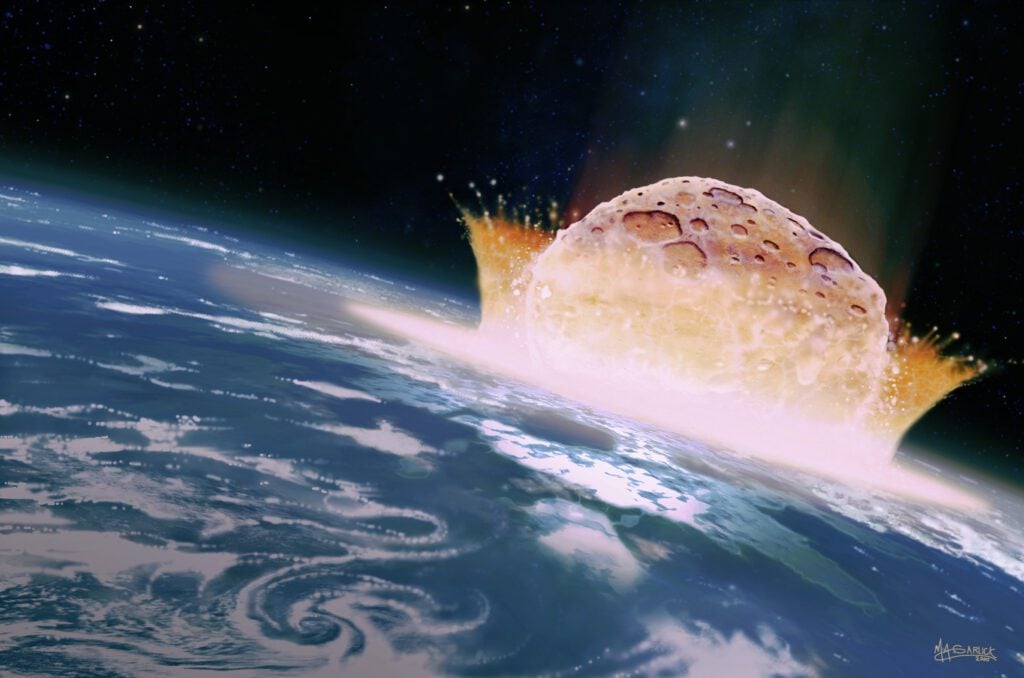A six-mile-wide asteroid called the Chicxlub slammed into the waters of Mexico that triggered the mass extinction of the dinosaurs and 70% of all Earth’s species. But did you know about the massive crater the asteroid created?
The asteroid impact that wiped out the dinosaurs ignited 70% of the world’s forests, caused tsunamis that rose to 300 feet, and ejected 25 trillion metric tons of debris into the atmosphere, reducing sunlight by up to 90% for a decade.
The Asteroid That Killed the Dinosaurs
Nobel Prize-winning physicist Luis Walter Alvarez and his geologist son Walter published a theory in 1980 that a giant asteroid colliding with Earth caused a historical layer of iridium-rich clay. The immediate devastation in the immediate vicinity and the widespread secondary effects of an asteroid impact was the reasons for the dinosaurs’ extinction.
Asteroids are large rocky bodies that revolve around the Sun. They range in size from a few meters to hundreds of meters. A meteorite is an asteroid fragment that survives its impact on Earth.
The Alvarez hypothesis was initially controversial, but it is now the most widely accepted theory for the Mesozoic extinction.
An asteroid impact is supported by good evidence because we’ve identified the crater. It’s now largely buried on the seafloor off the coast of Mexico. It is the same age as the extinction of the non-bird dinosaurs, which can be tracked in the rock record all around the world
Luis Walter Alvarez, Nobel Prize-Winning Physicist
The impact site, the Chicxulub crater, is located on Mexico’s Yucatán Peninsula. The asteroid was thought to be between 10 and 15 kilometers wide, but the velocity of its collision created a much larger crater, 150 kilometers in diameter – the planet’s second-largest crater.
Massive tidal waves washed over parts of the American continent due to the dinosaur-killing crash, which threw massive amounts of debris into the air. There is also evidence of significant fires from that period. It was long thought that non-bird dinosaurs died out 65 million years ago.
There is a lot of discussion over the actual kill mechanism and how long that period lasted. There are still a lot of unknowns. But it was a massive event affecting all life on Earth, from microorganisms all the way through to dinosaurs
Luis Walter Alvarez, Nobel Prize-Winning Physicist
(Source: Natural History Museum)
How Did Global Climate Change Affect Their Extinction?
The asteroid cannot be held entirely responsible. Earth was undergoing climate change at the time of the crash landing. This was making life on our planet more difficult.
There was significant volcanic activity in what is now central India, which, unrelated to the asteroid impact, was causing its own problems. The lava outcrop that resulted is now known as the Deccan Traps.
For two million years there was a huge amount of volcanic activity going on, spewing gases into the atmosphere and having a major impact on global climate. There were also longer-term changes. The continents were drifting around and splitting apart from each other, creating bigger oceans, which changed ocean and atmosphere patterns around the world. This also had a strong effect on climate and vegetation.
Luis Walter Alvarez, Nobel Prize-Winning Physicist
The last non-bird dinosaurs lived during a period of environmental change, some of which had begun millions of years before becoming extinct. The asteroid delivered the killing blow. (Source: Natural History Museum)
Image from Npr.org
